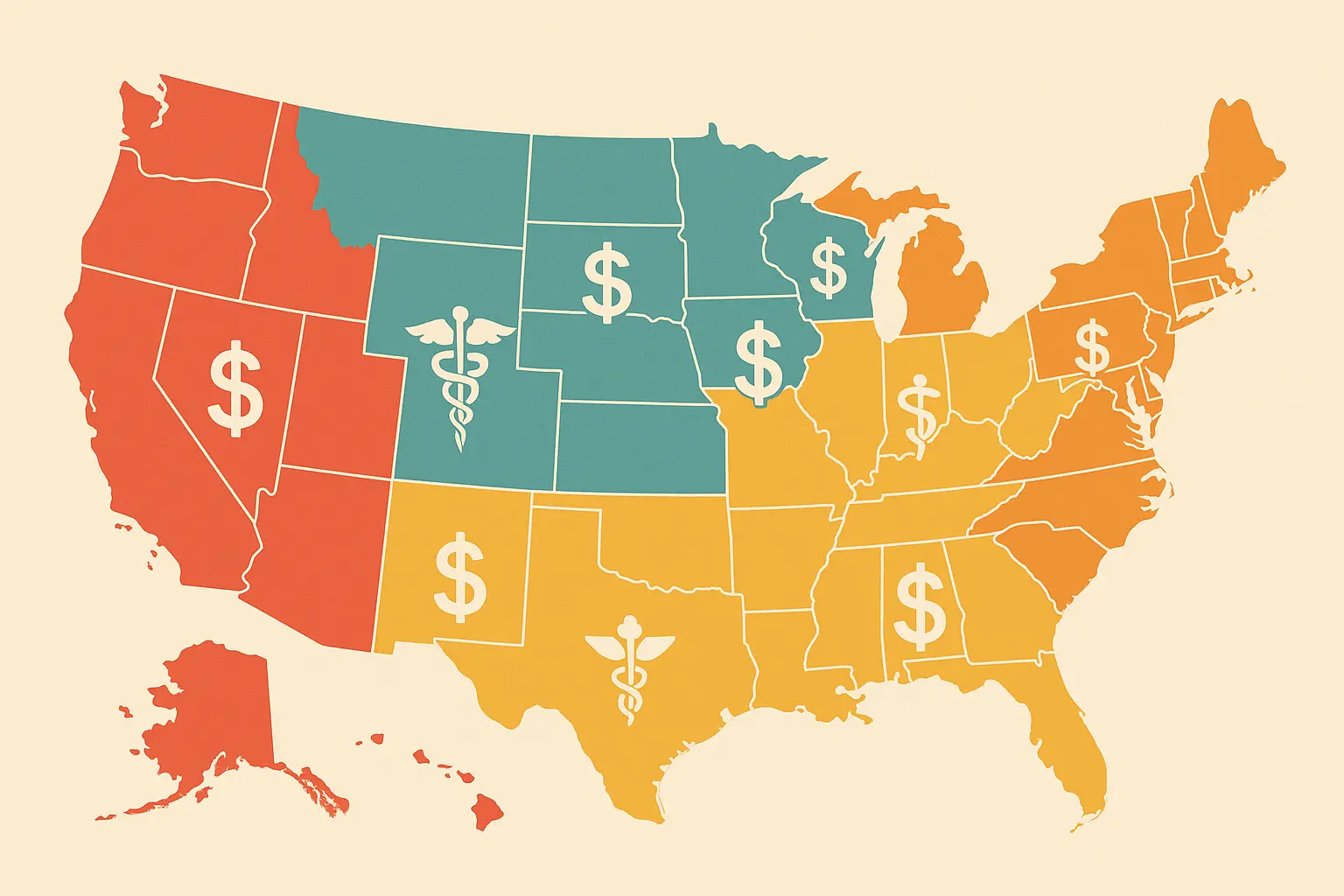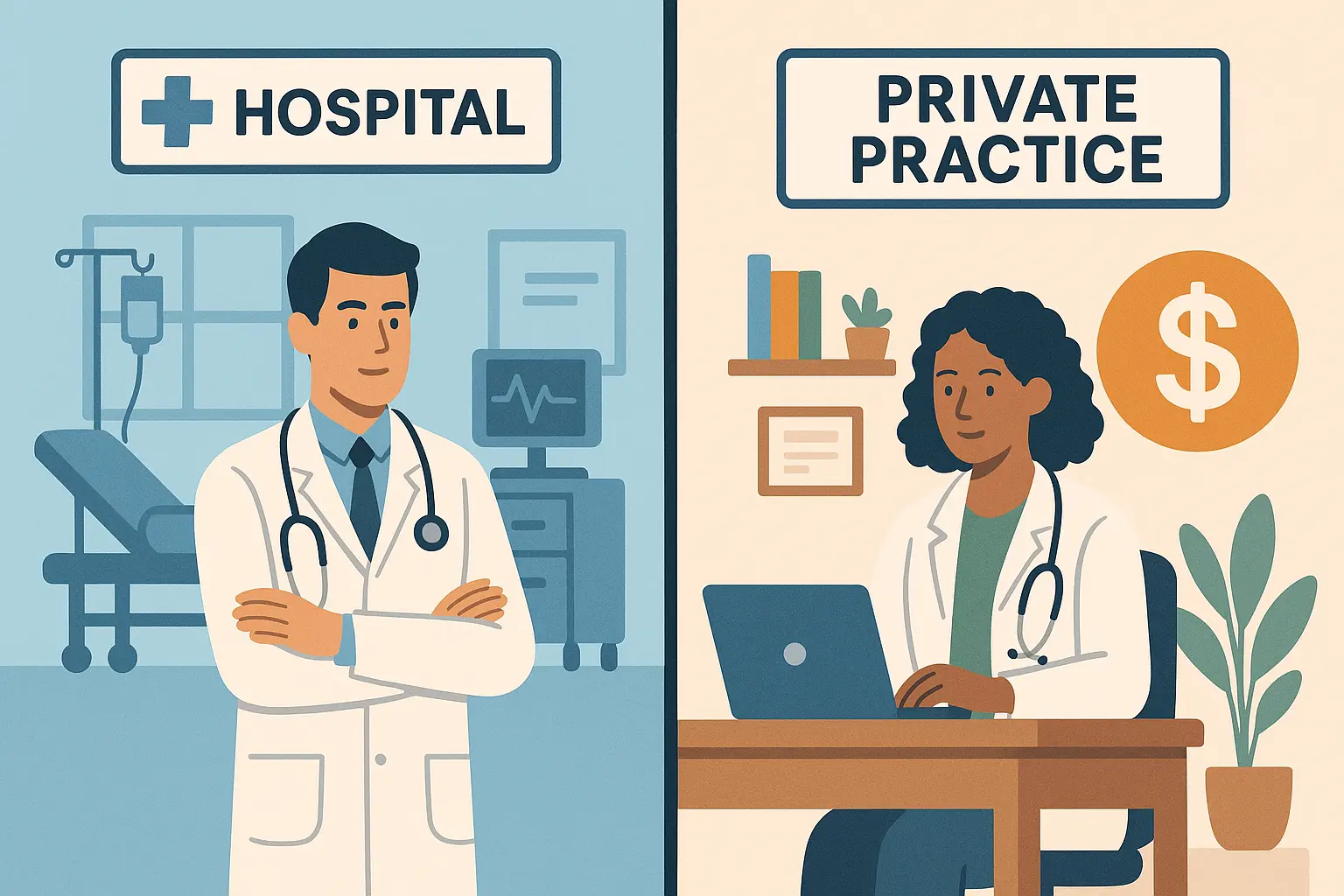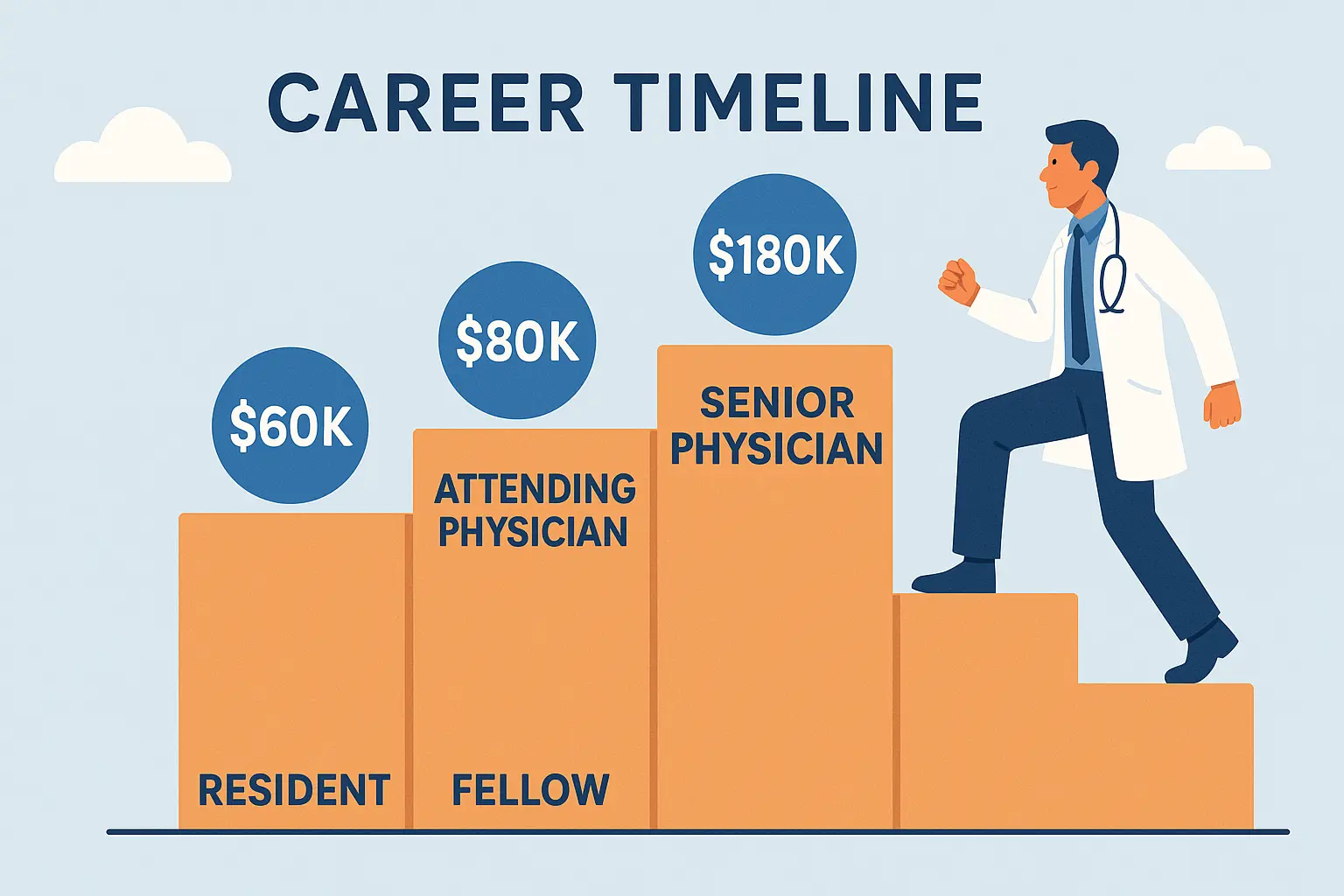What Anesthesiologists Really Make (And Why It’s Probably More Than You Think)

Look, I’ve been watching my colleagues navigate anesthesiology salaries for years, and here’s the truth: most doctors are selling themselves short. Way short.
Those generic anesthesiologist salary surveys? They’re missing half the story. While they’ll tell you the average is around $400K, I know locum anesthesiologists pulling in $275-$325 per hour versus $214 for permanent gigs. That’s not just a difference—that’s your kid’s college fund.
Whether you’re a resident trying to figure out your future or a practicing anesthesiologist wondering if you’re getting paid what you’re worth, I’m going to break down what actually determines your paycheck. No fluff, just the real numbers.
Table of Contents
- The Real Numbers (Not the Sanitized Survey Data)
- Location, Location, Location (But Not How You Think)
- Private Practice vs. Hospital: The Trade-Off Everyone Gets Wrong
- Subspecialties: Your Fast Track to the Big Leagues
- Your Career Timeline: The Real Progression
- Market Forces That’ll Shape Your Future
- Research and Negotiation: Stop Leaving Money on the Table
- The Real Talk
TL;DR
- Anesthesiologist salaries range from $300K-$500K+ annually, with subspecialists earning significantly more
- Rural positions often pay 15-25% premiums over urban markets to attract specialists
- Private practice typically offers higher earning potential than hospital employment but comes with business risks
- Pain management and cardiac anesthesia subspecialties can boost salaries by 20-40%
- Geographic location dramatically impacts compensation – some states consistently pay $100K+ more than others
- Total compensation packages include benefits worth 20-30% of base salary
- Effective salary negotiation requires market research and understanding your true value proposition
The Real Numbers (Not the Sanitized Survey Data)
Here’s what’s actually happening in the market right now. According to ZipRecruiter data, locums anesthesiologists see an average hourly rate of $275 – $325, significantly higher than permanent positions. Base anesthesiologist salary figures typically run $350K-$450K, but that’s just the starting point. Factor in bonuses, call pay, and regional differences, and you’re looking at total packages pushing well past $500K.
I’ve seen too many anesthesiologists focus only on that base number and miss the bigger picture. It’s like judging a house by its asking price without considering the neighborhood, schools, or potential for appreciation.
What You’ll Actually Take Home
Let me give you the breakdown by career stage:
Just Starting Out (Years 1-2): $300K-$350K base, but add call pay and bonuses, and you’re looking at $320K-$380K total.
Mid-Career (Years 3-7): $380K-$450K base, with performance bonuses pushing you to $420K-$500K.
Senior Level (8+ years): $450K-$550K base, but leadership premiums can get you to $650K.
Subspecialty-Trained: This is where the anesthesiologist salary trajectory gets interesting. $500K-$650K base, and procedure fees can push you past $750K.
Take Dr. Sarah Chen in Denver. Her base looked modest at $420K, but between weekend call coverage ($1,500/day), productivity bonuses (15% above base for exceeding case volume targets), and teaching stipends ($25K annually) at the university hospital, she cleared $580K last year. That’s the difference between knowing the game and just playing it.
When evaluating compensation offers, understanding how to effectively ask for a raise becomes crucial as your experience grows and market value increases.
Here’s what you can realistically expect at different career stages:
| Experience Level | Salary Range | Additional Compensation | Total Potential |
|---|---|---|---|
| Entry-Level (1-2 years) | $300K-$350K | Call pay, bonuses | $320K-$380K |
| Mid-Career (3-7 years) | $380K-$450K | Performance bonuses | $420K-$500K |
| Senior-Level (8+ years) | $450K-$550K | Leadership premiums | $500K-$650K |
| Subspecialty-Trained | $500K-$650K | Procedure fees | $550K-$750K |
Benefits That Actually Matter to Your Bottom Line
Smart anesthesiologists evaluate the complete package, including health insurance, retirement contributions (often 10-15% of salary), malpractice coverage, and continuing education allowances. These benefits typically add 20-30% to your total compensation value and shouldn’t be overlooked during job negotiations.
Compensation Package Checklist:
- ☐ Health insurance premium coverage (family vs individual)
- ☐ Retirement matching (401k, 403b contributions)
- ☐ Malpractice insurance coverage and tail coverage
- ☐ CME allowance ($5K-$15K annually)
- ☐ Vacation time and sabbatical policies
- ☐ Disability and life insurance coverage
- ☐ Student loan repayment assistance programs
Location, Location, Location (But Not How You Think)
Here’s where it gets counterintuitive. You’d expect New York or California to pay the most, right? Wrong.
When it comes to anesthesiologist salary trends, Wyoming, North Dakota, and Alaska are where the real money is. We’re talking $500K+ annually because these places are desperate for specialists. Rural Montana offered one of my colleagues $565K plus a $50K signing bonus just to show up.
The rule is simple: the harder it is to recruit someone, the more they’ll pay. Rural positions often offer 15-25% premiums over urban markets. Sure, you might miss the city amenities, but your bank account won’t complain.
States Where Anesthesiologists Strike Gold
Alaska faces enormous healthcare worker demand, requiring roughly 9,400 new healthcare workers each year, driving up compensation packages significantly. These premiums reflect the challenges of recruiting specialists to remote locations and the higher cost of living in certain regions.
The anesthesiology salary landscape shifted recently when Washington state passed legislation in 2024 allowing nurse anesthetists and certified anesthesiologist assistants to practice within a physician-led anesthesia care team to address a shortage of anesthesiologists. This change could impact future salary dynamics in the region.
Rural vs. Urban: The Great Salary Flip
Rural positions typically offer 15-25% salary premiums compared to urban markets, challenging the assumption that big cities always pay more. However, urban areas provide better long-term career advancement and subspecialty training opportunities that can increase lifetime earning potential.
A rural Montana hospital offered Dr. Michael Rodriguez $565K plus a $50K signing bonus, $15K relocation assistance, and guaranteed call coverage support – 23% higher than comparable urban positions in Denver or Seattle. This premium reflects what rural markets pay to attract specialists.
Private Practice vs. Hospital: The Trade-Off Everyone Gets Wrong
Hospital employment typically offers an anesthesiologist salary of $380K-$420K with great benefits and predictable hours. It’s the safe play.
Private practice? That’s where you can hit $450K-$600K+, but you’re running a business, not just practicing medicine. You’ll deal with overhead, staffing headaches, and business development. Some love it, others hate it.
The question isn’t which pays more—it’s which fits your personality and risk tolerance.
Hospital Employment: Steady Money, Predictable Life
Hospital-employed anesthesiologists typically earn $380K-$420K with comprehensive benefits and predictable schedules. This model offers stability and removes business management headaches, making it attractive for those prioritizing work-life balance over maximum earning potential.
Medical professionals considering various employment options should understand the importance of professional resume formatting to effectively present their qualifications to different types of healthcare organizations.
Private Practice: High Risk, Higher Rewards
Private practice offers the highest earning potential ($450K-$600K+) but requires business acumen and carries entrepreneurial risks. Success depends on your ability to manage both clinical excellence and business operations.
| Practice Setting | Average Salary | Benefits | Risk Level | Work-Life Balance |
|---|---|---|---|---|
| Hospital Employment | $380K-$420K | Comprehensive | Low | Predictable |
| Academic Medical Center | $350K-$400K | Excellent | Low | Research opportunities |
| Private Practice (Small) | $450K-$550K | Variable | Medium | Flexible |
| Private Practice (Large) | $500K-$650K | Good | Medium | Demanding |
| Ambulatory Surgery Center | $400K-$500K | Limited | Medium | Regular hours |
Subspecialties: Your Fast Track to the Big Leagues
Want to jump from $400K to $600K? Get fellowship training.
Pain Management: The compensation champion. You’re looking at 20-40% premiums over general anesthesia, often hitting $500K-$650K.
Cardiac Anesthesia: High-stress, high-reward. Major medical centers pay $480K-$580K for these skills.
Critical Care: Post-pandemic, these dual-trained anesthesiologists are gold. $450K-$550K and job security you can’t shake.
The math is simple: one year of fellowship training can add $100K-$200K annually for the next 30 years of your career.
Pain Management: The Compensation Champion
Pain management anesthesiologists can earn 20-40% more than general anesthesiologists, with salaries often reaching $500K-$650K. This subspecialty requires additional fellowship training but offers diverse practice opportunities including interventional procedures and clinic-based care.
Healthcare professionals pursuing specialized training should explore PA salary insights to understand how advanced practice roles complement physician compensation in various medical specialties.
Cardiac and Pediatric Anesthesia: Premium Pay for Premium Skills
These high-acuity subspecialties typically offer 15-25% salary premiums due to specialized training requirements and the critical nature of the work. Cardiac anesthesiologists in major medical centers can earn $480K-$580K annually, reflecting the specialized expertise required.
Critical Care Medicine: The Post-Pandemic Goldmine
Dual-trained anesthesiologists in critical care medicine command premium salaries ($450K-$550K) and enjoy increased job security due to growing ICU demands. The pandemic highlighted the value of these specialists, leading to sustained demand and competitive compensation packages.
The role of anesthesiologist assistants is expanding, with CAAs work directly under the supervision of a licensed anesthesiologist, potentially creating new collaborative care models that could impact future anesthesiologist compensation structures.
Your Career Timeline: The Real Progression
Here’s what actually happens to your paycheck over time, not the sanitized version you see in career guides.
Years 1-5: The Hustle Phase
You’ll start at 70-80% of what experienced docs make, but here’s the thing—you’ll jump 5-10% annually if you’re smart about it. This is when you build your reputation and figure out what kind of anesthesiologist you want to be.
Pro tip: Don’t just focus on base salary during these early years. Negotiate signing bonuses, get your relocation covered, and understand the call pay structure. These add up fast.
Early career professionals should utilize salary increase calculators to project long-term earning potential and make informed decisions about subspecialty training investments.
Early Career Salary Optimization Checklist:
- ☐ Negotiate signing bonus and relocation assistance
- ☐ Understand call pay structure and requirements
- ☐ Evaluate CME and professional development opportunities
- ☐ Consider moonlighting opportunities for additional income
- ☐ Plan subspecialty fellowship training timeline
- ☐ Build professional network and mentorship relationships
Years 6-15: Peak Earning Time
This is your sweet spot. You’ve got the skills, the confidence, and the market knowledge to make strategic moves. Subspecialty training pays off here. Leadership roles become available.
One colleague leveraged her cardiac training and MBA to become director of perioperative services—jumped from $485K to $625K in one move. That’s the power of positioning yourself right during these peak years.
Beyond Year 15: Maintenance or Leadership
You’ve got choices. Coast at peak earnings, or pivot into leadership for even more. Medical directorships and department chair positions often add 10-20% plus additional perks.
Market Forces That’ll Shape Your Future
The aging baby boomers aren’t just a demographic trend—they’re your job security. More surgeries, more procedures, more demand for your skills. This demographic wave is pushing salaries up 3-5% annually and will continue for the next decade.
But here’s what most people miss: technology is changing how we’re paid. Some systems are moving toward value-based care, which could shift compensation models. The smart money is on staying ahead of these trends rather than reacting to them.
The Aging Population Advantage
The growing elderly population increases demand for surgical procedures, potentially driving up anesthesiologist salaries by 3-5% annually over the next decade. This demographic trend particularly benefits subspecialties serving older patients, creating sustained upward pressure on compensation.
According to CompHealth, the average hourly rate for anesthesiologists in Washington, the state with the highest pay, is $214 for permanent positions, establishing baseline compensation benchmarks for salary negotiations.
Technology’s Double-Edged Impact
Advances in anesthesia technology and perioperative efficiency may impact traditional compensation models, with some systems moving toward value-based care arrangements. While technology improves patient outcomes, it also changes how anesthesiologists are compensated for their services.
Supply and Demand: Your Strategic Advantage
Regional shortages create opportunities. States like Alaska need roughly 9,400 new healthcare workers annually. That desperation translates directly into premium compensation packages. Regions with anesthesiologist shortages offer premium compensation packages, while oversupplied markets may see salary stagnation.
Research and Negotiation: Stop Leaving Money on the Table
Most anesthesiologists are terrible negotiators, and it costs them big time. Here’s how to fix that:
Do Your Homework Right
Skip the generic salary websites. Use ASA compensation surveys, MGMA data, and Medscape’s physician reports. Better yet, have actual conversations with colleagues in similar positions. Real data beats internet guesses every time.
Know What You’re Really Worth
Your value isn’t just your clinical skills. It’s your subspecialty training, your call availability, your teaching abilities, your leadership potential. Document all of it.
Finding Reliable Salary Data That Actually Matters
The American Society of Anesthesiologists (ASA) annual compensation survey, Medscape physician compensation reports , and MGMA data provide authoritative salary benchmarks. Professional networking and direct conversations with colleagues offer real-world insights that surveys might miss.
Don’t rely on generic anesthesiologist salary websites that lump all physicians together. Anesthesiology-specific data sources give you the precision needed for effective negotiations.
Contract Negotiation: Don’t Leave Money on the Table
Practice the Conversation
You’re not begging for money—you’re presenting your market value. There’s a difference, and it shows in how you approach the negotiation.
Consider the Whole Package
Base salary, call pay, productivity bonuses, benefits, CME allowance, vacation time—it all adds up. Sometimes a lower base salary with better call pay and benefits beats a higher base with nothing extra.
When preparing for salary negotiations, having a well-crafted ATS-friendly resume ensures your qualifications are properly presented to hiring managers and compensation committees.
Salary Negotiation Preparation Template:
- ☐ Research regional salary benchmarks (ASA, MGMA, Medscape data)
- ☐ Document your unique qualifications and subspecialty training
- ☐ Calculate total compensation value including benefits
- ☐ Prepare alternative compensation structures (hourly vs salary)
- ☐ Identify non-salary negotiable items (vacation, CME, schedule)
- ☐ Practice negotiation scenarios and responses
- ☐ Set minimum acceptable compensation threshold
Leadership: Your Path to Premium Pay
Administrative roles aren’t just about the extra 10-20% in salary (though that’s nice). They’re about diversifying your career and building influence within your organization.
Medical directorships, department leadership, quality improvement roles—these positions often come with protected time, additional compensation, and career advancement opportunities that pure clinical work doesn’t offer.
The catch? You need business skills, not just clinical ones. But for those willing to develop them, the financial rewards are substantial.
When you’re ready to pursue these high-paying anesthesiology opportunities, your resume becomes your first impression with potential employers. Resume Builder IQ’s AI-powered platform helps medical professionals create ATS-optimized resumes that effectively highlight clinical experience, subspecialty training, and leadership accomplishments. With specialized medical resume templates, you can present your qualifications in formats that resonate with hospital administrators and practice managers, positioning yourself to access the highest-paying positions and enter salary negotiations from a position of strength.
The Real Talk
Look, anesthesiology offers incredible earning potential, but maximizing it requires more than just showing up and doing good work. You need to think strategically about location, subspecialty training, practice setting, and career positioning.
The colleagues making $600K+ aren’t necessarily better doctors than those making $350K. They’re just better at understanding the market, positioning themselves strategically, and advocating for their worth.
Your clinical skills get you in the door. Your business sense and negotiation skills determine how much money walks through it with you.
Remember that your earning potential extends far beyond your base salary. Total compensation packages, subspecialty premiums, and leadership opportunities can significantly impact your lifetime earnings. The anesthesiologists who earn the most aren’t necessarily the most clinically skilled – they’re the ones who understand the business side of medicine and position themselves strategically in the market.
The anesthesiologists who consistently earn at the top of the range share one trait: they understand that medicine is both a calling and a business, and they’re comfortable operating in both worlds.









